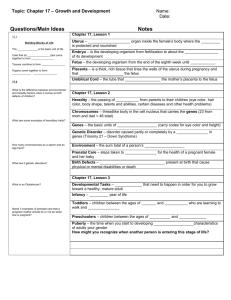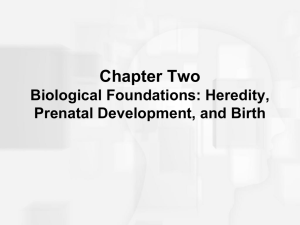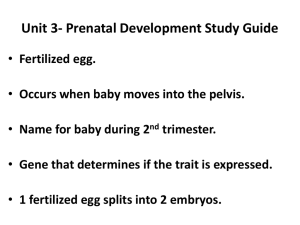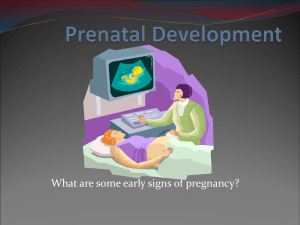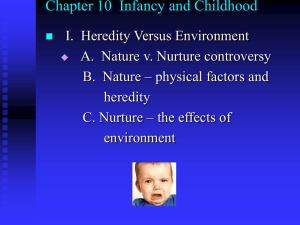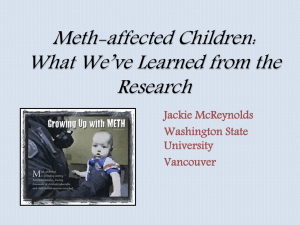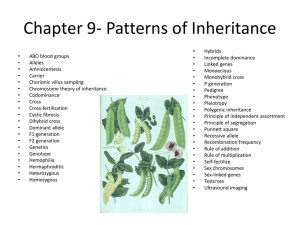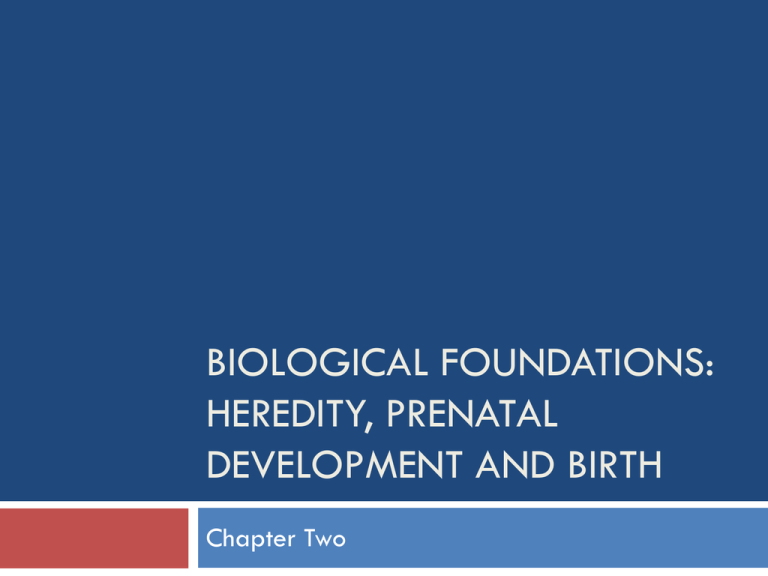
BIOLOGICAL FOUNDATIONS:
HEREDITY, PRENATAL
DEVELOPMENT AND BIRTH
Chapter Two
In The Beginning
Learning Objectives
What are chromosomes and genes?
How do they carry hereditary information from one
generation to the next?
What are common problems involving chromosomes
and what are the consequences?
How is a child’s heredity influenced by the
environment in which they grow?
Mechanisms of Heredity
Human eggs contain 23 chromosomes (threadlike
structures in the nucleus) selected from the mother’s
46
one chromosome is selected from each of the 23
pairs
Human sperm contains 23 chromosomes selected
from the father’s 46
one chromosome is selected from each of the 23
pairs
Mechanisms of Heredity
The human egg and sperm unite resulting in a
zygote
-contains a complete set of 46 chromosomes
- first 22 chromosomes are called autosomes
-23rd pair determines the gender of the child and
is called the sex chromosomes
-the 46 chromosomes contain around 30,000
genes
Mechanisms of Heredity
The 23rd Pair of Chromosomes
-Males carry XY Chromosomes
-X from mother and Y from father
-Females carry XX chromosomes
-X from mother and X from father
Mechanisms of Heredity
Each chromosome actually consists of one molecule
of deoxyribonucleic acid. (DNA)
To understand the structure of DNA, imagine:
Four
different chemical compounds placed on two strings
When two compounds (adenine, thymine, guanine,
cytosine)line up exactly they make chemical compounds
which are like a secrete code
Each group of compounds that provides a specific set of
biochemical instructions is called a gene
The strings wrap around each other to create a double
helix
Mechanisms of Heredity
Mechanisms of Heredity
Each group of compounds that provide a set of instructions is
a gene (functional unit of heredity)
Fewer than 1% of genes cause differences between people
Alleles – different forms of
genes i.e. sickle cells (recessive) and normal red cells (dominant)
The complete set of genes that make up a person’s heredity
is called a genotype
Phenotype - combined
effect of genotype and
environmental influences
Alleles
Characteristics are determined my the interaction of
genes on the two chromosomes in a pair
Each chromosome of a pair contains one parent’s
contribution to a specific trait
When genes (alleles)are the same, they are call
homozygous
When different alleles, they are called
heterozygous
Alleles
Homozygous Alleles
-When alleles are the same, both parents have
contributed similar genes for a trait
Heterozygous Alleles
-The parents have contributed different versions of
the trait
Dominant
alleles- instructions followed
Recessive alleles- instructions ignored
Alleles
Incomplete dominance results when one allele does
not dominate another completely. The result is a
trait as a sickle cell trait. In this instance the person
may have tempory problems only when seriously
short of O2 as when at high altitudes or when
exercising.
Some Common Phenotypes Associated with Single
Pair Genes
Dominant Phenotype
Recessive Phenotype
Curly Hair
Straight Hair
Normal Hair
Dark Hair
Patterns of Baldness
Blond Hair
Cheek dimples
Normal Hearing
No dimples
Some type of deafness
Normal Vision
Farsightedness
Normal color vision
Nearsightedness
Normal Vision
Green red blindness
Type A or B blood
Rh positive blood
Type O blood
Rh negative blood
Genetic Disorders
Inherited disorders involve dominant or recessive
alleles
-Sickle-Cell Disease, PKU and Huntington’s Disease
Extra, missing or damaged chromosomes result in
abnormalities of development
-Down’s Syndrome (extra 21st chromosome
provided by the egg), Turner’s Syndrome (X),and
Klinefelter’s Syndrome (XXY)
Heredity, Environment and Development
Behavioral Genetics
The study of the inheritance of behavioral and
psychological traits. Characteristics are not
either/or but are complex. Includes intelligence
and personality.
Twins
Dizygotic (fraternal) twins come from two different
eggs fertilized by two different sperm
Monozygotic (identical) twins come from the union of
one egg and one sperm that splits in two soon after
conception
Twins
Fraternal twins
-share much of the same experience and
environment
- have no more genetic similarity than other siblings
Identical twins
-share much the same experience
-genetically identical
Adopted siblings have different experiences and
some genetic similarity
Path From Genes to Behavior
Genes can influence the kind of environment to
which one is exposed.
Niche-picking (a bright child will seek like friends
etc.) – deliberately seeking environments that fir
one’s heredity
Environmental influences typically make children
within a family different due to nonshared
environmental influences.
Path From Genes to Behavior
Epigenesis – interplay between genes and multiple
levels of the environment from cellular level to
culture
Heritability coefficient – estimates the extent to
which differences between people reflect heredity.
Intelligence has a coefficient of 0.5 applied to
specific groups of people in a particular
environment. 50% of the differences in intelligence
between people is due to heredity.
From Conception to Birth
Learning Objectives
What happens to a fertilized egg in the first two
weeks after conception?
When do structures and internal organs emerge in
prenatal development?
When do body systems begin to function well
enough to support life?
Periods of Prenatal Development
Period of Zygote (Weeks 1-2)
From fertilization, the zygote travels down the
fallopian tube dividing every 12 hours, to the time
of
implantation in the uterine wall.
Germ disk – cluster of cells in the zygote that become the
baby
Period of the Embryo (Weeks 2-8)
Body structures, internal organs, and the three layers of the
embryo (ectoderm - hair, outer layer of skin, nervous system,
mesoderm-muscles, bones, circulatory system, and endodermdigestive system, lungs ) develop
The amniotic sac fills with fluid and the umbilical cord
connects the embryo to the placenta
Periods of Prenatal Development
Amnion – sac containing embryo and amniotic fluid
Umbilical cord houses vassals that exchange
nutrients and wastes with mother’s blood
Growth occurs by the cephalocaudal and
proximodistal principles
The period of the zygote spans 14 days that begin with fertilization of the egg in the fallopian tubes and end
with implantation of the fertilized egg in the wall of the uterus.
Periods of Prenatal Development
Zygote
Embryo
Periods of Prenatal Development
Period of the Fetus (Week 9-38 weeks Birth)
Week 9- Differentiation of the ovaries and testes,
cartilage becomes bone
Week 12- Circulatory system begins to function,
heart has been beating almost two months
Week 16- Movement felt by the mother
Week 22-28- Age of viability
Periods of Prenatal Development
Fetuses move – more active fetuses are more likely
to be unhappy difficult babies
Discern flavors
Hear
Remember after birth
The baby-to-be becomes much larger during the period of the fetus and its bodily systems start to work.
Conception in the
st
21
Century
-In Vitro fertilization
-inserting sperm directly into the Fallopian
tubes
-injecting sperm directly into the egg
Inserting fertilized eggs into the womb
Surrogate mothers
Picking sperm donors - is this engenics (improving
the human species by only allowing certain people
to mate)
Principles of Growth
Cephalocaudal Principle
-Growth from head to spine
Proximodistal Principle
-Growth from areas close to the body to farthest
from body
Influences of Prenatal Development
Learning Objectives
How is prenatal development influence by a
pregnant woman’s age, her nutrition, and the stress
she experiences while pregnant?
How do diseases, drugs, and environmental hazards
sometimes affect prenatal development?
What general principles affect the ways that
prenatal development can be harmed?
How can prenatal development be monitored? Can
abnormal prenatal development be corrected?
General Risk Factors
Nutrition
-Inadequate maternal nutrition may result in
premature birth and low birth weight. Need to
increase caloric intake by 10-20% and gain25 –
35 lbs. Take additional protein, vitamins, minerals.
Lack of folic acid during the first month may increase
risk for spina bifida
Stress
-Studies show extreme maternal stress is associated
with low birth weight and premature births
General Risk Factors
Mother’ Age
-Older mothers are more likely to have difficulty
getting pregnant, miscarriages, and stillbirths
-Nearly 50% of pregnancies among women in their
40’s and 50’s result in miscarriages
Teratogens
Teratogen = an agent that causes abnormal prenatal
development
3 categories:
Drugs
Disease
Environmental
hazards
Teratogens: Drugs
Known harmful agents include:
Alcohol - FAS,
Aspirin – Defects in intelligence,
attention, motor skills,
Caffeine – rotated growth irritability
Nicotine – growth and cognitive impairments
Marijuana – low birth rate, less motor control
Cocaine, heroin – retarded growth, irritability
Fetal Alcohol Syndrome
-Results from overuse of alcohol during pregnancy
-Children with FAS may have mental retardation,
facial deformities, and heart defects, retarded growth
Leading caues of developmental disabilities in US
Teratogens: Diseases
AIDS, Cytomegalovirus, Rubella (German Measles), Syphilis attack embryo of
fetus directly, Chicken Pox, Chlamydia, Genital Herpes, Toxoplasmosis
Aids and herpes attack as fetus passes through birth canal
-Effects include:
-neurological disorders
-deafness
-blindness
-mental disability
-damage to bones, eyes, ears, or heart
-frequent infections
-death
-prematurity
- miscarriage
-encephalitis
-damage to eyes, teeth, bones
Teratogens: Environmental Hazards
Lead, Mercury, PCB’s, X-Rays
-Effects may include:
-mental disability
-retarded growth
-cerebral palsy
-impaired memory and verbal skill
-leukemia
Prenatal Diagnosis and Treatment
Genetic Counseling
Helps to assess the chances of inherited disorders
Prenatal Diagnosis
Ultrasound – sound waves used to generate a picture of the
developing fetus – 4yh or 5yh week. Determine position ,sex,
abnormalities, number
Amniocentesis – needle inserted through the abdominal wall into the
uterus to obtain a sample of amniotic fluid, determine genotype,
danger miscarriage
Chorionic Villus Sampling – sample of fetal cells obtained from a
part of the placenta ,earlier 9-12 weeks, than amniocentesis, danger
miscarriage
Prenatal Diagnosis and Treatment
Fetal Medicine
-Administering medicine to the fetus,ie.for
hypothyroidism, adrenal hyperplasia, excess
androgens
-Fetal surgury to correct spina bifida and
circulatory problems
-Genetic engineering involves replacing defective
genes with synthetic normal genes
Labor and Delivery
Learning Objectives
What are the different phases of labor and
delivery?
What are the natural ways of coping with the pain
of childbirth? Is childbirth at home safe?
What adjustments do parents face after a baby’s
birth?
What contributes to infant mortality in the
developed and least developed countries?
Stage of Labor
Stage 1
-last 12-24 hours for the first birth
-contractions and enlargement of the cervix to
approximately 10 centimeters,4-6 hrs for subsequent deliveries
Stage 2
-actual birth of the baby
-lasts about an hour first birth , 2o
min subsequent
Stage 3
-lasts a few minutes
-expulsion of the placenta
Approaches to Childbirth
Childbirth classes
-Explains what happens during pregnancy and
delivery
-Teaches techniques to manage the pain of
childbirth
-natural methods, relaxation and coaching
-Studies show that mothers who attend childbirth
classes typically use less medication
Birthing Alternatives
Home Births
-less expensive
-parents have more control over the conditions
-birth problems are no more common at home then
at the hospital when pregnancy has been
problem-free
Birthing Centers
-more home-like then hospitals
-clinic setting independent of hospital
Adjusting to Parenthood
Physical changes in the woman – breasts producing
milk, levels of female hormones drop,
Adjustments to infants sleep-wake cycle and neeeds
Father often suffers reduced attention
Postpartum depression can last years affecting the
child’s development
Labor and Delivery:
Birth Complications
Cephalopelvic Disproportion – baby’s head is larger
than the pelvis; baby can’t pass through the birth canal
Irregular position – shoulder presentation: baby is lying
crosswise in the uterus and the shoulder appears first;
breech presentation: buttocks appear first
Preeclampsia – a pregnant woman has high BP, protein
in her urine, and swelling in her extremities due to fluid
retention
Prolapsed Umbilical Cord – the umbilical cord precedes
the baby through the birth canal and is squeezed shut,
cutting off oxygen to the baby (hypoxia) leading to
mental retardation or death
Labor and Delivery
Birth Complications
Hypoxia, or inadequate blood and oxygen to the baby
Complications may result in a cesarean section (C-section
Births before the 36th week are called premature or
preterm
-weighing less the 5.5 pounds (2500 grams) have low birth
weight
-weighing less than 3.3 pounds 1500 grams) have very low
birth weight
-weighing 2.2 pounds (1000 grams) or less is call
extremely low birth weight
Labor and Delivery
Birth Complications
Birth complications can lead to aggression, violence
or schizophrenia in the child
Higher risk for children born into family adversity
and/or poverty
Excellent health care needed during pregnancy
Supportive environment needed throughout
childhood
Infant Mortality
Infant mortality is the number of infants out of 1,000
births that die before the age of 1 year
-U.S. mortality rate is just under 1%, or 7 of 1,000
-15 industrialized nations have lower infant
mortality than the U.S.
Possible factors include:
-low birth weight
-lack of free or inexpensive prenatal care
-fewer paid leave of absences for pregnant women
Infant Mortality
In Afghanistan 1in 6 babies die within the first year,
has the highest infant mortality rate in the world
In Czech Republic, Iceland, Finland, Japan odds are
1 in 300 of dying before first birthday
13 developed countries have lower infant mortality
rates than US mainly because of lacking medical
care, due to lack of insurance. Other developed
countries have free or low cost medical care.
If US reduced it’s mortality rate to 4% AS IN
Europe, 8000 babies would not die annually.

